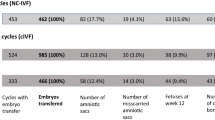Purpose : To investigate the effects of follicle number and size at the time of hCG administration, and ovarian stimulation length on the outcome of in vitro fertilization and pregnancy rate.
Methods : During the ovarian stimulation regimen, the follicular number and size were determined by transvaginal ultrasonographic examination. Ovulation was induced as early as three or more follicles were at least 16 mm in their greatest diameter.
Results : The fertilization rates were significantly increased with the longer length of stimulation (10–12 days: 75.4% and 13–16 days: 83.2%). However, no significant differences in the chemical pregnancy, clinical pregnancy, and implantation rates were found between 10–12 days (53.7%, 43.9%, and 21.8%) and 13–16 days (50.0%, 43.8%, and 23.4%) of stimulation. There were no significant differences in fertilization and chemical pregnancy rates between two groups with ≥ and <18 follicles in the ovaries on the day of hCG (human chorionic gonadotrophin) administration. However, the clinical pregnancy and implantation rates (47.2% and 26.0%) in the group with <18 follicles were significantly higher than those (33.3% and 15.5%) in the group with ≥18 follicles, respectively.
Conclusions : Excessive and rapid ovarian stimulation appears to decrease the survival of embryos at later stages after transfer. The advantage of prolonged stimulation may outweigh the potential adverse effects in some patients.
Similar content being viewed by others
REFERENCES
Van Wissen B, Eisenberg C, Debey P, Pennehouat G, Auger J, Bomsel-Helmreich O: In vitro DNA fluorescense after in vitro fertilization (IVF) failure. J Assist Reprod Genet 1992;9:564–571
Chiu TTY, Tam PPL: A correlation of the outcome of clinical in vitro fertilization with the inositol content and embryotrophic properties of human serum. J Assist Reprod Genet 1992;9:524–530
Laufer N, DeCherney AH, Tarlatzis BC, Zuckerman AL, et al.: Delaying human chorionic gonadotropin administration in human menopausal gonadotropin-induced cycles decreases successful in vitro fertilization of human oocytes. Fertil Steril 1984;42:198–203
Clark L, Stanger J, Brinsmead M: Prolonged follicle stimulation decreases pregnancy rates after in vitro fertilization. Fertil Steril 1991;55:1192–1194
Catherino WH, Leondires M, McKeeby J, Cruess D, Segars JH, et al.: Prolonged ovarian stimulation in ART cycles does not improve clinical pregnancy rates in poor responders. Fertil Steril 2002;78:S49
Dimitry ES, Bates SA, Oskarsson T, Margara R, Winston RML: Programming in vitro fertilization for a 5- or 3-day week. Fertil Steril 1991;55:934–938
Dimitry ES, Oskarsson T, Conaghan J, Margara R, Winston RML: Beneficial effects of a 24-h delay in human chorionic gonadotropin administration during in vitro fertilization treatment cycles. Hum Reprod 1991;6:944–946
Tan SL, Balen A, Hussein E, Mills C, Campbell S, Yovich J, et al.: A prospective randomized study of the optimum timing of human chorionic gonadotropin administration after pituitary desensitization in in vitro fertilization. Fertil Steril 1992;57:1259–1264
Palermo G, Joris H, Devroey P, van Steirteghem AC: Pregnancies after intracytoplasmic injection of single spermtozoon into an oocyte. Lancet 1992;340:17–18
Ben-Rafael Z, Koof GS, Blasco L, Flickinger GL, et al.: Follicular maturation parameters associated with the failure of oocyte retrieval, fertilization, and cleavage in vitro. Fertil Steril 1986;45:51–57
Battaglia C, Regnani G, Petraglia F, Genazzani AR, Artini PG, Volpe A: The use of a starting dose of recombinant follicle stimulating hormone for controlled ovarian hyperstimulation: A randomized pilot study. Gynecol Endocrinol 2000;14:311–315
Jones HW Jr, Acosta AA, Andrews MC, Garcia JE, Jones GS, Mayer J, et al.: Three years of in vitro fertilization at Norfork. Fertil Steril 1984;42:826–834
Crozet N, Kanka J, Motlik, et al.: Nucleolar fine structure and RNA synthesis in bovine oocytes from antral follicles. Gamete Res 1986;14:65–74
Sirard MA, Florman HM, Liebfried-Rutledge ML, et al.: Timing of nuclear progression and protein synthesis necessary for meiotic maturation of bovine oocytes. Biol Reprod 1989;40:1257–1263
Eppig JJ, Schultz RM, O'Brien M, et al.: Relationship between the developmental programs controlling nuclear and cytoplasmic maturation of mouse oocytes. Dev Biol 1994;164:1–9
Ivani KA, Weckstein LN, Walker DM: Effect of length of stimulation in ART cycles on pregnancy rate. Fertil Steril 2003;80:181–182
Borm G, Mannaerts B: Treatment with the gonadotropin-releasing hormone antagonist ganirelix in women undergoing ovarian stimulation with recombinant follicle stimulating hormone is effective, safe, and convenient: Results of a controlled, randomized, multicentre trial. The European Orgalutran Study Group. Hum Reprod 2000;15:1490–1498
Fluker M, Grifo J, Leader A, Levy M, Meldrum D, Muasher SJ, et al.: Efficacy and safety of ganirelix acetate versus leuprolide acetate in women undergoing controlled ovarian hyperstimulation. Fertil Steril 2001;75:38–45
Kolibianakis E, Bourgain C, Albano C, Osmanagaoglu K, Smitz J, van Steirteghem A, et al.: Effect of ovarian stimulation with recombinant follicle-stimulating hormone, gonadotropin-releasing hormone antagonists, and human chorionic gonadotropin on endometrial maturation on the day of oocyte pick-up. Fertil Steril 2002;78:1025–1029
Kolibianakis EM, Albano C, Kahn J, Camus M, Tournaye H, van Steriteghem AC, et al.: Exposure to high levels of luteinizing hormone and estradiol in the early follicular phase of gonadotropin-releasing hormone antagonist cycles is associated with a reduced chance of pregnancy. Fertil Steril 2003;79:873–880
Garcia-Velasco JA, Isaza V, Vidal C, Landazabal A, Remohi J, Simon C, et al.: Human ovarian steroid secretion in vivo: Effects of GnRH agonist versus antagonist (cetrorelix). Hum Reprod 2001;16:2533–2539
Morgan PM, Warikoo PK, Bavister BD: In vitro maturation of ovarian oocytes from unstimulated rhesus monkeys: Assessment of cytoplasmic maturity by embryonic development after in vitro fertilization. Biol Reprod 1991;45:89–93
Author information
Authors and Affiliations
Corresponding author
Rights and permissions
About this article
Cite this article
Tao, T., Robichaud, A., Nadeau, S. et al. Optimized Hormonal Stimulation Is Critical for Production of Viable Embryos and Establishment of Subsequent Implantation. J Assist Reprod Genet 23, 23–28 (2006). https://doi.org/10.1007/s10815-005-9005-1
Received:
Accepted:
Published:
Issue Date:
DOI: https://doi.org/10.1007/s10815-005-9005-1




